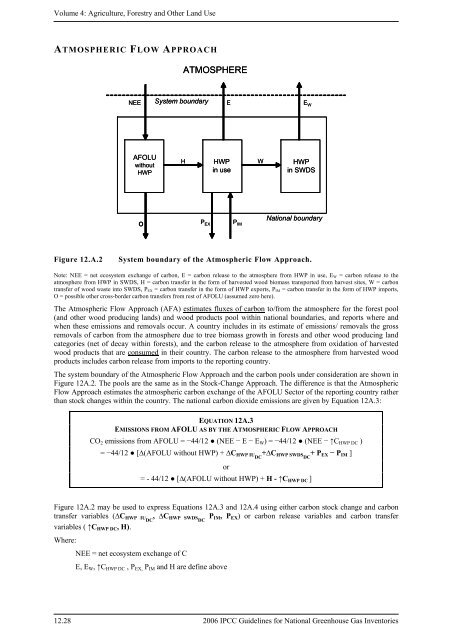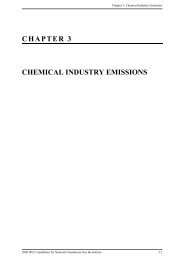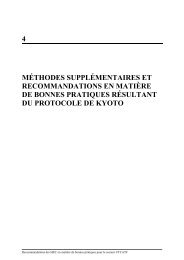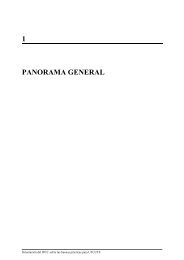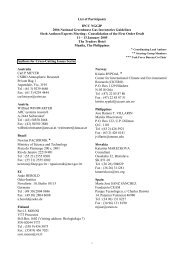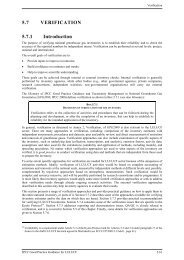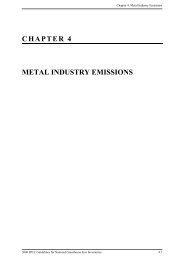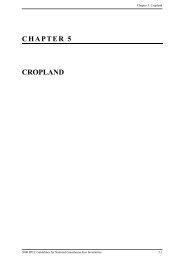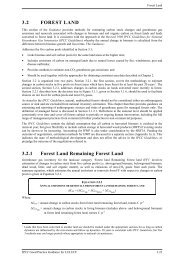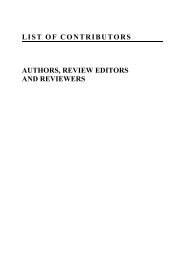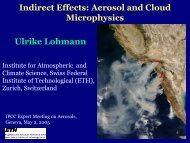chapter 12 harvested wood products - IPCC - Task Force on ...
chapter 12 harvested wood products - IPCC - Task Force on ...
chapter 12 harvested wood products - IPCC - Task Force on ...
Create successful ePaper yourself
Turn your PDF publications into a flip-book with our unique Google optimized e-Paper software.
Volume 4: Agriculture, Forestry and Other Land Use<br />
ATMOSPHERIC FLOW APPROACH<br />
ATMOSPHERE<br />
NEE System boundary E<br />
E W<br />
AFOLU<br />
H<br />
HWP<br />
W<br />
HWP<br />
without<br />
HWP<br />
in use<br />
in SWDS<br />
Nati<strong>on</strong>al boundary<br />
O<br />
P EX P IM<br />
Figure <str<strong>on</strong>g>12</str<strong>on</strong>g>.A.2<br />
System boundary of the Atmospheric Flow Approach.<br />
Note: NEE = net ecosystem exchange of carb<strong>on</strong>, E = carb<strong>on</strong> release to the atmosphere from HWP in use, E W = carb<strong>on</strong> release to the<br />
atmosphere from HWP in SWDS, H = carb<strong>on</strong> transfer in the form of <str<strong>on</strong>g>harvested</str<strong>on</strong>g> <str<strong>on</strong>g>wood</str<strong>on</strong>g> biomass transported from harvest sites, W = carb<strong>on</strong><br />
transfer of <str<strong>on</strong>g>wood</str<strong>on</strong>g> waste into SWDS, P EX = carb<strong>on</strong> transfer in the form of HWP exports, P IM = carb<strong>on</strong> transfer in the form of HWP imports,<br />
O = possible other cross-border carb<strong>on</strong> transfers from rest of AFOLU (assumed zero here).<br />
The Atmospheric Flow Approach (AFA) estimates fluxes of carb<strong>on</strong> to/from the atmosphere for the forest pool<br />
(and other <str<strong>on</strong>g>wood</str<strong>on</strong>g> producing lands) and <str<strong>on</strong>g>wood</str<strong>on</strong>g> <str<strong>on</strong>g>products</str<strong>on</strong>g> pool within nati<strong>on</strong>al boundaries, and reports where and<br />
when these emissi<strong>on</strong>s and removals occur. A country includes in its estimate of emissi<strong>on</strong>s/ removals the gross<br />
removals of carb<strong>on</strong> from the atmosphere due to tree biomass growth in forests and other <str<strong>on</strong>g>wood</str<strong>on</strong>g> producing land<br />
categories (net of decay within forests), and the carb<strong>on</strong> release to the atmosphere from oxidati<strong>on</strong> of <str<strong>on</strong>g>harvested</str<strong>on</strong>g><br />
<str<strong>on</strong>g>wood</str<strong>on</strong>g> <str<strong>on</strong>g>products</str<strong>on</strong>g> that are c<strong>on</strong>sumed in their country. The carb<strong>on</strong> release to the atmosphere from <str<strong>on</strong>g>harvested</str<strong>on</strong>g> <str<strong>on</strong>g>wood</str<strong>on</strong>g><br />
<str<strong>on</strong>g>products</str<strong>on</strong>g> includes carb<strong>on</strong> release from imports to the reporting country.<br />
The system boundary of the Atmospheric Flow Approach and the carb<strong>on</strong> pools under c<strong>on</strong>siderati<strong>on</strong> are shown in<br />
Figure <str<strong>on</strong>g>12</str<strong>on</strong>g>A.2. The pools are the same as in the Stock-Change Approach. The difference is that the Atmospheric<br />
Flow Approach estimates the atmospheric carb<strong>on</strong> exchange of the AFOLU Sector of the reporting country rather<br />
than stock changes within the country. The nati<strong>on</strong>al carb<strong>on</strong> dioxide emissi<strong>on</strong>s are given by Equati<strong>on</strong> <str<strong>on</strong>g>12</str<strong>on</strong>g>A.3:<br />
EQUATION <str<strong>on</strong>g>12</str<strong>on</strong>g>A.3<br />
EMISSIONS FROM AFOLU AS BY THE ATMOSPHERIC FLOW APPROACH<br />
CO 2 emissi<strong>on</strong>s from AFOLU = −44/<str<strong>on</strong>g>12</str<strong>on</strong>g> ● (NEE − E − E W ) = −44/<str<strong>on</strong>g>12</str<strong>on</strong>g> ● (NEE − ↑C HWP DC )<br />
= −44/<str<strong>on</strong>g>12</str<strong>on</strong>g> ● [∆(AFOLU without HWP) + ∆C HWP IUDC +∆C HWP SWDSDC + P EX − P IM ]<br />
or<br />
= - 44/<str<strong>on</strong>g>12</str<strong>on</strong>g> ● [∆(AFOLU without HWP) + H - ↑C HWP DC ]<br />
Figure <str<strong>on</strong>g>12</str<strong>on</strong>g>A.2 may be used to express Equati<strong>on</strong>s <str<strong>on</strong>g>12</str<strong>on</strong>g>A.3 and <str<strong>on</strong>g>12</str<strong>on</strong>g>A.4 using either carb<strong>on</strong> stock change and carb<strong>on</strong><br />
transfer variables (∆C HWP IUDC , ∆C HWP SWDSDC P IM , P EX ) or carb<strong>on</strong> release variables and carb<strong>on</strong> transfer<br />
variables ( ↑C HWP DC , H).<br />
Where:<br />
NEE = net ecosystem exchange of C<br />
E, E W , ↑C HWP DC , P EX, P IM and H are define above<br />
<str<strong>on</strong>g>12</str<strong>on</strong>g>.28 2006 <str<strong>on</strong>g>IPCC</str<strong>on</strong>g> Guidelines for Nati<strong>on</strong>al Greenhouse Gas Inventories


